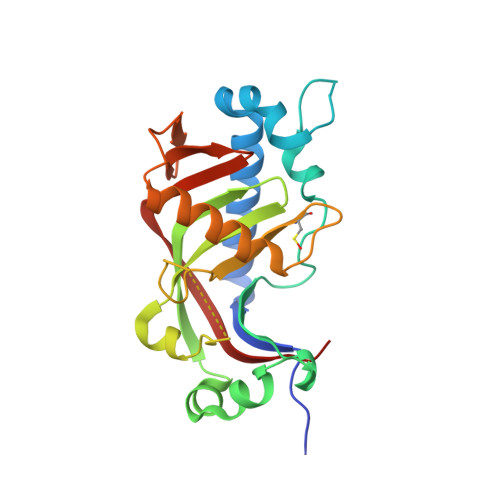Determinants of ligand binding and catalytic activity in the myelin enzyme 2',3'-cyclic nucleotide 3'-phosphodiesterase.
Raasakka, A., Myllykoski, M., Laulumaa, S., Lehtimaki, M., Hartlein, M., Moulin, M., Kursula, I., Kursula, P.(2015) Sci Rep 5: 16520-16520
- PubMed: 26563764
- DOI: https://doi.org/10.1038/srep16520
- Primary Citation of Related Structures:
4WBI, 4WBL, 4WC9, 4WCA, 4WCB, 4WCC, 4WDA, 4WDB, 4WDD, 4WDE, 4WDF, 4WDG, 4WDH, 4WEX, 4WFR, 5AE0 - PubMed Abstract:
2',3'-cyclic nucleotide 3'-phosphodiesterase (CNPase) is an enzyme highly abundant in the central nervous system myelin of terrestrial vertebrates. The catalytic domain of CNPase belongs to the 2H phosphoesterase superfamily and catalyzes the hydrolysis of nucleoside 2',3'-cyclic monophosphates to nucleoside 2'-monophosphates. The detailed reaction mechanism and the essential catalytic amino acids involved have been described earlier, but the roles of many amino acids in the vicinity of the active site have remained unknown. Here, several CNPase catalytic domain mutants were studied using enzyme kinetics assays, thermal stability experiments, and X-ray crystallography. Additionally, the crystal structure of a perdeuterated CNPase catalytic domain was refined at atomic resolution to obtain a detailed view of the active site and the catalytic mechanism. The results specify determinants of ligand binding and novel essential residues required for CNPase catalysis. For example, the aromatic side chains of Phe235 and Tyr168 are crucial for substrate binding, and Arg307 may affect active site electrostatics and regulate loop dynamics. The β5-α7 loop, unique for CNPase in the 2H phosphoesterase family, appears to have various functions in the CNPase reaction mechanism, from coordinating the nucleophilic water molecule to providing a binding pocket for the product and being involved in product release.
Organizational Affiliation:
Faculty of Biochemistry and Molecular Medicine, University of Oulu, Oulu, Finland.















